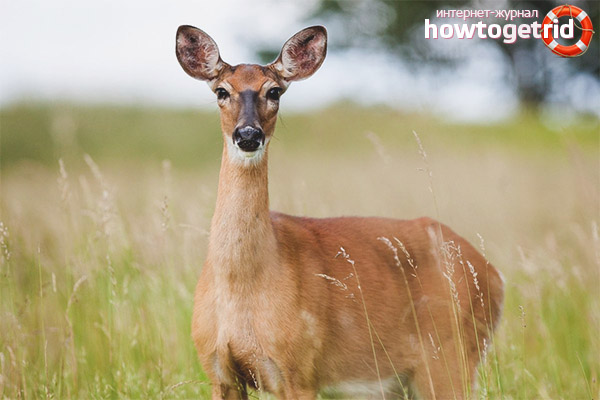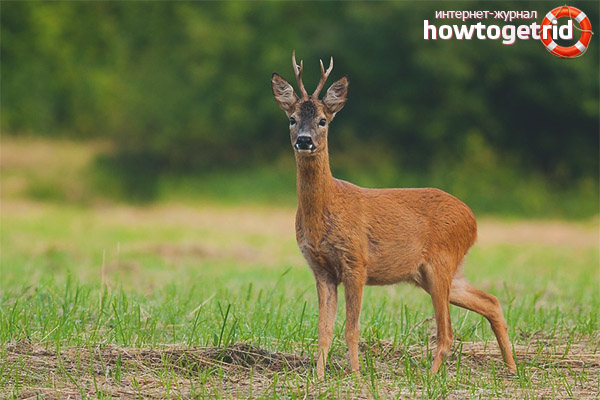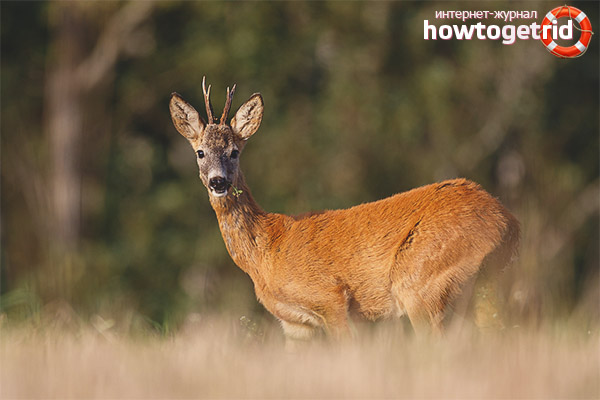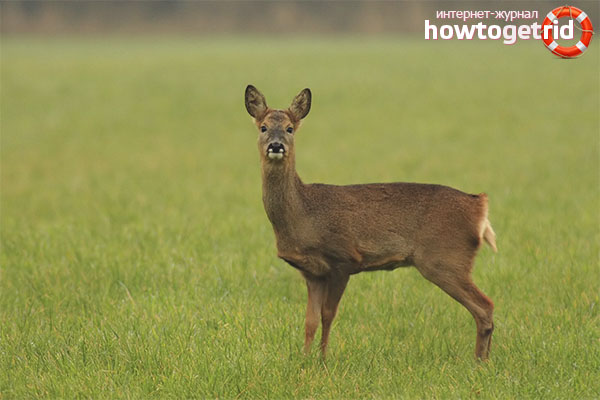The content of the article
Otherwise, European roe deer are called wild goats, very often these representatives of the family become victims of predators. In today's article, we will consider everything that affects these individuals. How do they prefer to get food, where do they live, what is the mating season. There are many aspects, let's talk about them in order of priority.
Description
- Representatives of this species have a relatively small body, it is rather shortened or medium, but not elongated. The back section of the body rises, so it seems that the forelimbs are shorter. The croup is thick and sloping. By weight, animals reach about 23 kg. Their body length is 100-130 cm. As for the height at the withers, animals grow to 80 cm maximum.
- Sexual dimorphism is manifested in the fact that the males are slightly larger. However, in some cases it is invisible at all. The largest representatives of the species are in the eastern and northern parts of their distribution range. The head is shortened, in the format of a wedge, tapering to the nose. The eye area is wide and high. The skull in this area is expanding, the front part is short but wide. The ears are oval and elongated, with sharp edges. Large-format eyes, bulging, pupils set crookedly.
- The cervical elongated, tightened. The limbs are long, not too thick, the hooves are short. The tail is hidden under a woolen coat. In the summer and autumn, individuals of male gender sweat a lot. They also develop a pungent and strongly smelling secret, with which animals mark their territorial possessions. These animals do not see very well, but they are distinguished by excellent hearing, which allows them to recognize the danger in time and run away. The sense of smell is also well developed.
- In males, horns are moderately large, but do not stand out. The process above the orbits is absent, the main horn bends to the back. The horns are rounded in format, they have many mounds and sections. You can confuse a similar structure with a socket. Certain individuals have abnormally developed horns. They begin their formation at the age of 4-5 months. Horns slowly grow and branch up to 3 years. Animals dump them in the middle of the autumn season or the beginning of winter.
- Individuals of the female sex do not have horns, but in individual specimens they can grow in an ugly form. As for body pigmentation, adult animals are solid. They are painted grayish or brown-gray with a transition to a brownish pigment in the back of the body. But this is a winter robe. In all other times, individuals are usually brownish, beige, gray-brown. The caudal part is light red or whitish, as well as the caudal disc.
- When it is summer time, roe deer change their color. They become uniform and reddish, but lightening can be observed in the abdomen. As a rule, they are either whitish or light red. Pigmentation of the body in summer is more uniform. There are some varieties, for example, in Germany, which are pigmented in black. They can be glossy, matte, gray-brown-black.
Lifestyle
- These animals are characterized by activity at different time intervals. A certain time is allotted for food, another period takes rest, the third is created for movements and walks. Especially often, these animals are awake in the early morning or at dusk, however, the final style of behavior depends on the territory of distribution and other aspects.This includes the season, time of day, anxiety or lack thereof, etc.
- Animals make beautiful runners. This is what they use when they are about to escape from a hunting tiger or other predator. Roe deer can reach 60 kilometers per hour and even more. When she eats, she moves through the pasture without haste or fuss. She stops, listens to her surroundings and relies completely on her feelings.
- In the summer and autumn, individuals move a lot at dusk to protect themselves from blood-sucking insects. In the winter, feeding takes longer, because you need to cover energy reserves and eat enough for the future. At this time, at least half a day is allocated for grazing. The rest of the time, individuals digest food and rest. When animals are at rest, they move in steps or trot. If danger is brewing, then a gallop with jumps is used.
Habitat
- The discussed representatives of the species inhabit larch, mixed stripes, and other forest-steppe areas. They do not live in coniferous zones, if there are not even a couple of larch trees, from which a quality litter is obtained. There are no animals in the wilderness, deserts, semi-deserts. It is important for them that a feed base is present at the distribution site. It is better if sparse forest strips with bushes and lawns will act as permanent territories for habitation.
- In the summer, they can graze in tall grass, undergrowth with shrubs. They like floodplain ravines, clearings, overgrown areas. Artiodactyls do not graze in the forests. If you look at a generalized, all members of the family are classified as forest-steppe. However, many people like the shrubby type rather than a completely overgrown with trees or an open area.
- The individuals under discussion adapted to live next to people, in cultivated landscapes and in other separate areas. Animals quickly adapt to changes in the environment and climatic conditions, so if necessary they can move to another place. Very often individuals are found near agricultural land. They can hide under needles exclusively during bad weather.
- When choosing a permanent habitat, mammals emphasize the presence or absence of feed. It is also important that there are natural or artificial shelters nearby where the animal will hide from predators.
Life span
- It is worth noting that individuals reach puberty at the age of approximately 6 years. At such a time, animals begin to prepare for the breeding season. The problem is that when the animal grows up, it begins to absorb nutrients that enter the body with food worse.
- As a result, the physiological state of individuals becomes much weaker than before puberty. In addition, all sorts of external factors negatively affect the general condition of the animal.
- Thus, the maximum age of the animals was 15 years. This roe deer lived in the wild in Australia. Specialists specifically mark individuals after capture, then release them into the wild. In this way, they can monitor her entire life cycle. Roe deer live in captivity for 25 years.
Nutrition
- It is noteworthy that wild goats have an extensive diet. Their main menu may include various types of plants. However, in most cases artiodactyls try to feast on easily digestible food saturated with water.
- Almost 70% of the main menu of such individuals is represented by dicotyledonous herbaceous plants. Also, various tree species are included in the daily diet. The rest of the roe deer do not mind eating lichens, moss, mocks, ferns and mushrooms.
- In addition, the presented individuals with pleasure eat various cereal crops.Artiodactyls feed on fireweed, highlander, catchment, sorrel, hemophobia, angelica and cow parsnip. Particular preference is given to aquatic plants.
- Most often, such food is found on lakes and swamps. Roe deer eat nuts, berries, acorns and chestnuts there. The animals in question are quite smart, they regularly eat medicinal plants that have antiparasitic effects.
- In addition, individuals know how to replenish mineral reserves in the body. They regularly visit salt licks and drink local water. Such a liquid is rich in various minerals. The rest of artiodactyls get water mainly from snow and plants.
- Animals need only 1.5 liters per day. water. With the onset of the cold season, the diversity of the diet is significantly reduced. Roe deer feed on shrubs, buds and tree shoots. They also consume dry grass and unflouded leaves.
- When there is not enough food at all, wild animals try to dig lichens and mosses out from under the snow. Sometimes bark and needles come across. At such a time, roe deer can dig holes in the snow in search of food up to 50 cm. If an individual finds something, it immediately eats the whole thing.
- Due to the small volume of the stomach and an accelerated metabolism, animals need frequent nutrition. Especially enhanced nutrition is necessary for pregnant women. This also includes roe deer that feed young animals with milk.
- Males before the rut try to gain strength and also eat a lot. When there is enough food, such animals do not eat up all available food, they only partially bite it. As a result, roe deer can harm various crops and crops.
Natural enemies
- These individuals in the wild have a lot of natural enemies. Large and medium-sized predatory animals actively hunt roe deer. The main enemy of artiodactyls are wolves and lynxes. Young animals are mainly hunted by badgers, foxes and martens.
- With the onset of the winter period, wolves begin to hunt especially for roe deer. It is in snowy time that it is extremely difficult for the considered individuals to move around. Therefore, roe deer become extremely vulnerable.
- It is worth noting that predatory animals attack not only weakened roe deer, but also quite healthy ones. When heavy snowfalls begin, much more artiodactyls and their cubs die. This is due to the hunting of predators and lack of food.
Breeding
- Most often, in the animals presented, the mating season falls in mid-August. At this time, the males acquire strong horns and a torso in general. Gon occurs in light forests, forest edges and shrubs. During the mating season, males eat little and chase females.
- During this time, 1 male can fertilize up to 5-6 females. Roe deer are the only cloven-hoofed latent animals. Therefore, the period of pregnancy can last 260-320 days. Most often, young animals are born at the beginning of a vein.
Roe deer are quite interesting artiodactyls. Due to special weather conditions and predators, the number of individuals is gradually declining. Roe deer may soon become endangered.
Video: European Roe Deer (Capreolus capreolus)













Submit